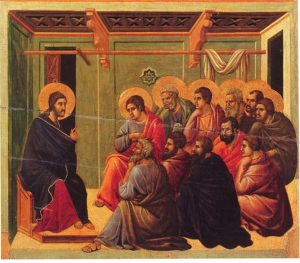CAN WE TRUST JOHN? Part 2
There are five crucial questions to ask when considering the reliability of the Bible. Last week we considered the first two questions regarding John, Who? and When? This week we ask about truth:
when considering the reliability of the Bible. Last week we considered the first two questions regarding John, Who? and When? This week we ask about truth:
3 Does the author intend to be truthful? 4 Is he actually truthful or does he let his prejudices get in the way?
John very helpfully gives us the reason for the writing of the gospel in 20.31. ‘These are written so that you may come to believe that Jesus is the Messiah, the Son of God, and that through believing you may have life in his name.’ This implies two things: a) that he did not include anything that was not directly useful for his primary purpose, e.g. the parables in the synoptics; and b) in the incidents and words he did record, he felt free to point out the spiritual moral to his readers. I.e. he did not indulge in Fiction, but he may have felt free to use both Fact and Faction.
It is in the letters that John is most explicit about the factual nature of his preaching. ‘What we have heard, what we have seen with our eyes,, what we have looked at and touched with our hands… we declare to you what we have seen and heard…’ (1 John 1, 3). Also there is the remarkable passage after Jesus has died on the cross: ‘One of the soldiers pierced his side with a spear, and at once blood and water came out. (He who saw this has testified so that you also may believe. His testimony is true, and he knows that he tells the truth).’ (John 19.34,35)
But there is a problem. John may have been an eyewitness to the crucifixion, but there is a lot of his gospel where he was not present, i.e. Andrew’s talk with Simon and Philip’s conversation with Nathanael (1.41-46); the conversation with Nicodemus (3.1-10) ; the talk between John the Baptist and a Jew (3.25-30); the Samaritan woman at the well (4.7-26); the meeting between the Capernaum official and his servants (4.51-53); discussion between the Jews among themselves (7.31-36); and that between the temple guards and the Pharisees (7.45-52); the investigation of the man born blind (9.8-34); the meeting of the Jewish council (11.46-53); Mary Magdalen’s meeting with the risen Jesus. In all these accounts, John was dependent on other people’s memories; possibly those of Nicodemus, the woman of Samaria, the man born blind etc. But of course, John was living in the situation, so the masterly writing up of these encounters, while in my view not word for word accurate, gives the flavour of the encounter by someone who was around.
Let’s return to the purpose of the gospel: ‘that you may come to believe that Jesus is the Messiah… and that you may have life in his name’. It seems to me that John deliberately uses people with whom his readers can identify, whether grumbly newcomers like Nathanael, confused people like Nicodemus, outsiders like the woman of Samaria, the doubters in the crowd, even a Roman official like Pilate. It also accounts for the red line he draws between those who follow Jesus and the antagonistic Jewish authorities. For John the latter have simply put themselves beyond the pale. But down the centuries people have identified with the characters in John’s gospel and come to ‘have life in his name’.
Next week I will tackle the thorny question: Is there more than one kind of truth?
